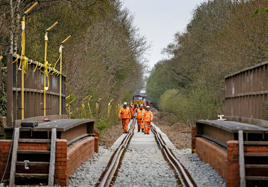Case studies
The Dartmoor Line is the headline act - the first (and so far, only) example of the Government’s ‘Restoring your Railway’ or ‘reversing Beeching’ programmes, returning regular passenger services to the line after almost half a century.
It was completed two years ahead of schedule and way under budget. The anticipated price was £89 million. The final cost was £47m - a 51% saving. And passenger numbers are already 200% higher than predicted in the first year, despite opening during the pandemic.
“Dartmoor was our real test case,” says Irwin. “Delivering in seven months and 28 days from the day the funding was announced, to the day it opened.”
A boost to the East Coast Main Line power supply is less headline-friendly, but arguably more significant. ‘Static frequency converters’ are being used. In the past, pylons would have been built from a new power supply from the National Grid, with a cost estimate of £1m per mile of railway. The converters ‘plug in’ to existing cables, cleaning the local power supply to optimise it for electric trains. Cost saving: £500m.
Replacing the railway flyover at Bletchley is a third Project Speed effort, carrying the East West Rail line from Bicester. A ‘box’ structure feels more like placing the lines beneath in a short tunnel. Some 70% of the box and flyover components were manufactured in advance and assembled onsite. “Like a model kit or set of Duplo bricks,” says Network Rail.
It also meant the railway did not have to be closed during the flyover construction, as the box provides a safe physical barrier. This reduced the cost by £70m, reduced the workforce by 60%, and shaved six months off the timescale of the project. And it’s claimed the new structure will last 120 years (the old one only managed 60 years).
Flatpack bridges are a third cheaper than other railway station pedestrian bridges. Think of it as an Ikea design, able to be customised with different components, but conforming to a common formula.
The components of the bridge are manufactured offsite. Because it is an off-the-shelf design, project time can be trimmed by 75% compared with Network Rail’s previous individually specified footbridges.
The lifts have a dual system to minimise downtime and disruption. The result is 34% cheaper than before, taking only one-third of the previous time on site, and more than halving the carbon footprint.
Lineside buildings: we’ve all seen the state of some of Network Rail’s 18,000 small buildings. The company reckons half of them are in desperate need of repair.
There’s a trial to ‘wrap’ rather than replace the buildings - essentially, a modular kit to assemble around the outside of the existing building. Network Rail says it is like armour, making equipment housing fireproof, moistureproof and better insulated. It also reduces energy consumption.
A building can be wrapped by three or four people in two days at a cost of £150,000, representing a claimed 92% efficiency saving. Critically, it can be done without closing the railway. NR reckons each unit will pay for itself in four years through energy savings and lower maintenance.













